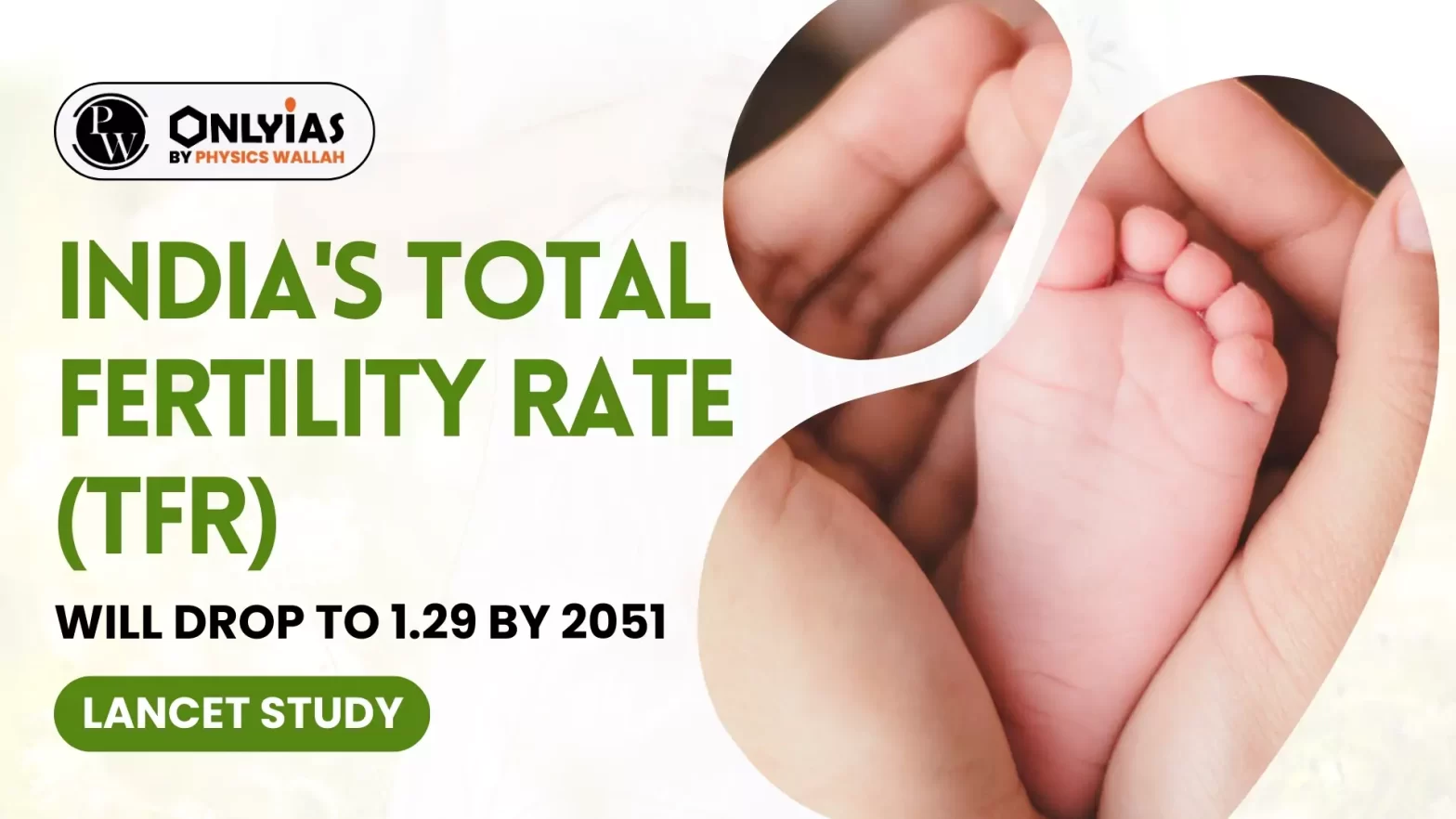Context
Recently, the Lancet has published a paper estimating that India’s Total Fertility Rate (TFR) will drop to 1.29 by 2051.
India’s Demographic Projections and Trends
- United Nations Estimates: The UN Population Division predicts that India’s population will reach over 1.7 billion by 2065 before it starts to decline.
- Lancet Estimates: According to Lancet study, the total fertility rate (TFR) would fall to 1.29 by 2051.
- Shift in Population Dynamics: These projections point to a shift in India’s demographic dynamics, with possible consequences beyond sheer quantity.
- NFHS Estimates: Government predictions and statistics from NFHS 5 show a lowering TFR trajectory, implying that population stabilization may occur sooner than expected.
Reasons for Demographic Transition in India
- Rapid Economic Development: India’s economy has grown at a remarkable pace during the last two decades.
- Reduction in Infant Mortality Rate: Infant and child mortality rates have been significantly reduced. It has reduced the requirement for a large family to help the elderly.
- Increase in Levels of Education: Women’s participation in the workforce has increased as their educational levels have improved.
- Improved Old- age Security: The old-age security scheme and improved housing conditions have also helped India’s demographic transformation.
Implications of Declining India’s Total Fertility Rate
- Estimate on Dependency Rate: A lower dependency ratio indicates that the working-age population bears a smaller burden of supporting dependents, allowing for increased economic production and resource allocation to development projects.
- The dependency ratio, taking the young and the old as a fraction of the percentage of the working-age population, is projected to go up from 13.8 in 2011 to 23 in 2036 for India.
- Increased Labour Supply: With a bigger working-age population than dependents, there may be more labour supply, which could lower wages in certain industries.
- Higher Wages: Industries with shortages of labor may need to raise wages to attract workers.
- Social Welfare and Healthcare services: As the population ages due to decreased birth rates and rising life expectancy, there is a growing demand for elderly-specific social welfare and healthcare services.
- Decrease in Demand for Quality Education: As fewer children enter the school-age population, the need for primary and secondary educational facilities and resources may diminish.
- For Example: This is already happening in Kerala
- Skill Development among Marginalized Sections: Skill development among SCs/STs and religious minorities can ensure there is no dearth of labor in the modern growing sectors.
- Resource Reallocation: A lowering total fertility rate (TFR) implies a shift in resources away from childcare and schooling costs for bigger families and towards investments in education, skill development, and healthcare for a smaller cohort of children.
- Investment in Human Capital Development: This shift in resource allocation allows for more efficient use of public funding and private investments, resulting in longer-term improvements in human capital development and productivity gains.
- Capital Accumulation & Investment: As fertility rates fall, households devote more resources to the education and well-being of fewer children.
- Higher Household Savings: This leads to higher household savings and investment, as families prefer long-term financial security and asset accumulation over immediate consumption.
- Accelerated economic growth: As the fertility rate falls, the dependency rate falls, and the proportion of working people in the population increases. This will generate surplus income, which can accelerate economic growth and result in positive intergenerational transfers.
- Increased labor productivity: As population growth slows, the amount of capital resources and infrastructure accessible per capita increases.
- Increased Investment in Education: As fertility rates fall, households devote more resources to the education and well-being of fewer children.
- Improvement in educational quality: As the fertility rate falls, the number of children enrolled in school will decrease. This could increase educational achievements because there will be more resources and infrastructure available per person.
- Enhanced participation of women in the workforce: Women engage in childcare during a productive era of their lives. With a decreased fertility rate, there will be less time for childcare, perhaps increasing women’s engagement in the labour.
- For example, in the southern states, women’s participation in MGNREGA jobs has improved.
- Redistribution of labor: Industrially developed states such as the southern states, Gujarat, and Maharashtra, which have low fertility rates, can obtain cheaper labour from the northern states.
- This could lead to better working conditions, the elimination of wage discrimination for migrant workers, and the reduction of security concerns in receiving countries via institutional safeguards.
- Balancing of Sectoral Distribution: The shifting of the workforce from agriculture to industries and services would balance the sectoral distribution.
Conclusion
India’s demographic change marks a watershed moment in its socioeconomic trajectory. While problems abound, smart policies focusing on skill development, women’s empowerment, labour redistribution, and healthcare preparation can help the country achieve long-term growth and development.
Also Read: Evolution Of Indian Population
| Prelims PYQ (2018):
Consider the following statements: Human capital formation as a concept is better explained in terms of a process which enables
1. individuals of a country to accumulate more capital.
2. increasing the knowledge, skill levels and capacities of the people of the country.
3. accumulation of tangible wealth.
4. accumulation of intangible wealth.
Which of the statements given above is/are correct?
(a) 1 and 2
(b) 2 only
(c) 2 and 4
(d) 1, 3 and 4
Ans: (c) |
![]() 5 Apr 2024
5 Apr 2024

